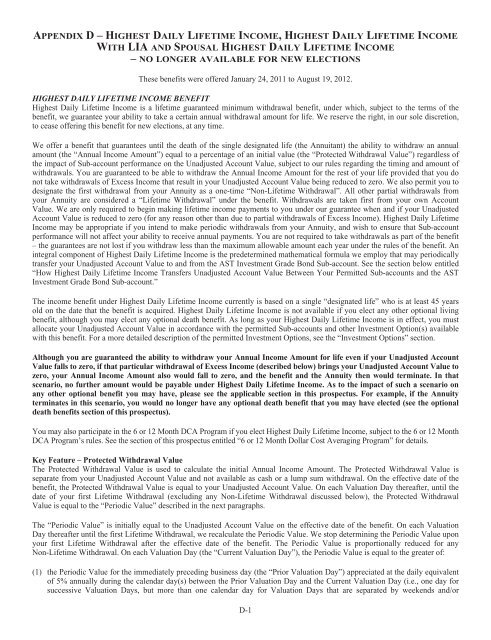Prudential Premier Retirement Variable Annuities
Prudential Premier Retirement Variable Annuities
Prudential Premier Retirement Variable Annuities
Create successful ePaper yourself
Turn your PDF publications into a flip-book with our unique Google optimized e-Paper software.
APPENDIX D–HIGHEST DAILY LIFETIME INCOME, HIGHEST DAILY LIFETIME INCOME<br />
WITH LIA AND SPOUSAL HIGHEST DAILY LIFETIME INCOME<br />
– NO LONGER AVAILABLE FOR NEW ELECTIONS<br />
These benefits were offered January 24, 2011 to August 19, 2012.<br />
HIGHEST DAILY LIFETIME INCOME BENEFIT<br />
Highest Daily Lifetime Income is a lifetime guaranteed minimum withdrawal benefit, under which, subject to the terms of the<br />
benefit, we guarantee your ability to take a certain annual withdrawal amount for life. We reserve the right, in our sole discretion,<br />
to cease offering this benefit for new elections, at any time.<br />
We offer a benefit that guarantees until the death of the single designated life (the Annuitant) the ability to withdraw an annual<br />
amount (the “Annual Income Amount”) equal to a percentage of an initial value (the “Protected Withdrawal Value”) regardless of<br />
the impact of Sub-account performance on the Unadjusted Account Value, subject to our rules regarding the timing and amount of<br />
withdrawals. You are guaranteed to be able to withdraw the Annual Income Amount for the rest of your life provided that you do<br />
not take withdrawals of Excess Income that result in your Unadjusted Account Value being reduced to zero. We also permit you to<br />
designate the first withdrawal from your Annuity as a one-time “Non-Lifetime Withdrawal”. All other partial withdrawals from<br />
your Annuity are considered a “Lifetime Withdrawal” under the benefit. Withdrawals are taken first from your own Account<br />
Value. We are only required to begin making lifetime income payments to you under our guarantee when and if your Unadjusted<br />
Account Value is reduced to zero (for any reason other than due to partial withdrawals of Excess Income). Highest Daily Lifetime<br />
Income may be appropriate if you intend to make periodic withdrawals from your Annuity, and wish to ensure that Sub-account<br />
performance will not affect your ability to receive annual payments. You are not required to take withdrawals as part of the benefit<br />
– the guarantees are not lost if you withdraw less than the maximum allowable amount each year under the rules of the benefit. An<br />
integral component of Highest Daily Lifetime Income is the predetermined mathematical formula we employ that may periodically<br />
transfer your Unadjusted Account Value to and from the AST Investment Grade Bond Sub-account. See the section below entitled<br />
“How Highest Daily Lifetime Income Transfers Unadjusted Account Value Between Your Permitted Sub-accounts and the AST<br />
Investment Grade Bond Sub-account.”<br />
The income benefit under Highest Daily Lifetime Income currently is based on a single “designated life” who is at least 45 years<br />
old on the date that the benefit is acquired. Highest Daily Lifetime Income is not available if you elect any other optional living<br />
benefit, although you may elect any optional death benefit. As long as your Highest Daily Lifetime Income is in effect, you must<br />
allocate your Unadjusted Account Value in accordance with the permitted Sub-accounts and other Investment Option(s) available<br />
with this benefit. For a more detailed description of the permitted Investment Options, see the “Investment Options” section.<br />
Although you are guaranteed the ability to withdraw your Annual Income Amount for life even if your Unadjusted Account<br />
Value falls to zero, if that particular withdrawal of Excess Income (described below) brings your Unadjusted Account Value to<br />
zero, your Annual Income Amount also would fall to zero, and the benefit and the Annuity then would terminate. In that<br />
scenario, no further amount would be payable under Highest Daily Lifetime Income. As to the impact of such a scenario on<br />
any other optional benefit you may have, please see the applicable section in this prospectus. For example, if the Annuity<br />
terminates in this scenario, you would no longer have any optional death benefit that you may have elected (see the optional<br />
death benefits section of this prospectus).<br />
You may also participate in the 6 or 12 Month DCA Program if you elect Highest Daily Lifetime Income, subject to the 6 or 12 Month<br />
DCA Program’s rules. See the section of this prospectus entitled “6 or 12 Month Dollar Cost Averaging Program” for details.<br />
Key Feature – Protected Withdrawal Value<br />
The Protected Withdrawal Value is used to calculate the initial Annual Income Amount. The Protected Withdrawal Value is<br />
separate from your Unadjusted Account Value and not available as cash or a lump sum withdrawal. On the effective date of the<br />
benefit, the Protected Withdrawal Value is equal to your Unadjusted Account Value. On each Valuation Day thereafter, until the<br />
date of your first Lifetime Withdrawal (excluding any Non-Lifetime Withdrawal discussed below), the Protected Withdrawal<br />
Value is equal to the “Periodic Value” described in the next paragraphs.<br />
The “Periodic Value” is initially equal to the Unadjusted Account Value on the effective date of the benefit. On each Valuation<br />
Day thereafter until the first Lifetime Withdrawal, we recalculate the Periodic Value. We stop determining the Periodic Value upon<br />
your first Lifetime Withdrawal after the effective date of the benefit. The Periodic Value is proportionally reduced for any<br />
Non-Lifetime Withdrawal. On each Valuation Day (the “Current Valuation Day”), the Periodic Value is equal to the greater of:<br />
(1) the Periodic Value for the immediately preceding business day (the “Prior Valuation Day”) appreciated at the daily equivalent<br />
of 5% annually during the calendar day(s) between the Prior Valuation Day and the Current Valuation Day (i.e., one day for<br />
successive Valuation Days, but more than one calendar day for Valuation Days that are separated by weekends and/or<br />
D-1

















